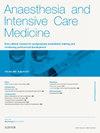Difficult and failed intubation in obstetric anaesthesia
IF 0.3
Q4 ANESTHESIOLOGY
引用次数: 0
Abstract
Difficult intubation in obstetric anaesthesia remains an important cause of maternal morbidity and mortality. Recent quoted estimates for difficult intubation vary between 1:19 and 1:49 whilst for failed intubation they vary between 1:180 and 1:808. Physiological changes during pregnancy, low general anaesthesia (GA) rates in obstetrics contributing to limited training opportunities, increased obstetric activity performed out-of-hours, a time-pressure environment, isolated location, and obstetric emergencies for which a GA is often utilized are cited contributing to difficult and failed intubation in obstetrics. Human factors often contribute to most situations in difficult and failed intubations. Recent studies seem to highlight that the majority of risk factors contributing to difficult or failed intubation in obstetrics are non-obstetric in nature. Propofol use during GA in obstetric surgery has been associated with a lower risk of difficult intubation. The joint Difficult Airway Society (DAS) and Obstetric Anaesthetists’ Association (OAA) guidelines offer a structured algorithmic approach with decision-making tools to enhance safety. Key strategies include understanding contributing factors, thorough preoperative assessment, planning, good communication and multidisciplinary training and simulation. Adherence to these guidelines is crucial for reducing the maternal and fetal morbidity from difficult or failed intubation during obstetric general anaesthesia.
产科麻醉插管困难和失败
产科麻醉插管困难仍然是孕产妇发病和死亡的一个重要原因。最近引用的插管困难的估计在1:19和1:49之间,而插管失败的估计在1:180和1:808之间。妊娠期间的生理变化、产科全麻率低导致培训机会有限、非工作时间产科活动增加、时间压力大的环境、偏僻的地点以及经常使用全麻的产科急诊被认为是造成产科插管困难和失败的原因。人为因素经常导致插管困难和插管失败的大多数情况。最近的研究似乎强调,导致产科插管困难或失败的大多数危险因素本质上是非产科的。在产科手术中使用异丙酚与较低的插管困难风险有关。困难气道协会(DAS)和产科麻醉师协会(OAA)联合指南提供了一种结构化的算法方法和决策工具,以提高安全性。关键策略包括了解影响因素、全面的术前评估、计划、良好的沟通以及多学科培训和模拟。遵守这些指南对于减少产科全身麻醉期间因插管困难或插管失败引起的孕产妇和胎儿发病率至关重要。
本文章由计算机程序翻译,如有差异,请以英文原文为准。
求助全文
约1分钟内获得全文
求助全文
来源期刊

Anaesthesia and Intensive Care Medicine
ANESTHESIOLOGY-
CiteScore
0.50
自引率
0.00%
发文量
152
期刊介绍:
Anaesthesia and Intensive Care Medicine, an invaluable source of up-to-date information, with the curriculum of both the Primary and Final FRCA examinations covered over a three-year cycle. Published monthly this ever-updating text book will be an invaluable source for both trainee and experienced anaesthetists. The enthusiastic editorial board, under the guidance of two eminent and experienced series editors, ensures Anaesthesia and Intensive Care Medicine covers all the key topics in a comprehensive and authoritative manner. Articles now include learning objectives and eash issue features MCQs, facilitating self-directed learning and enabling readers at all levels to test their knowledge. Each issue is divided between basic scientific and clinical sections. The basic science articles include anatomy, physiology, pharmacology, physics and clinical measurement, while the clinical sections cover anaesthetic agents and techniques, assessment and perioperative management. Further sections cover audit, trials, statistics, ethical and legal medicine, and the management of acute and chronic pain.
 求助内容:
求助内容: 应助结果提醒方式:
应助结果提醒方式:


